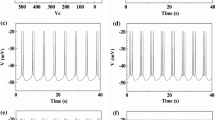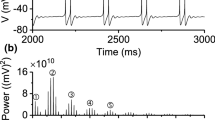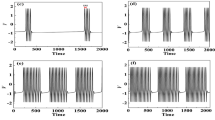Abstract
The Morris-Lecar (ML) neuronal model with current-feedback control is considered as a typical fast-slow dynamical system to study the combined influences of the reversal potential V Ca of Ca2+ and the feedback current I on the generation and transition of different bursting oscillations. Two-parameter bifurcation analysis of the fast subsystem is performed in the parameter (I, V Ca)-plane at first. Three important codimension-2 bifurcation points and some codimension-1 bifurcation curves are obtained which enable one to determine the parameter regions for different types of bursting. Next, we further divide the control parameter (V 0, V Ca)-plane into five different bursting regions, namely, the “fold/fold” bursting region R1, the “fold/Hopf” bursting region R2, the “fold/homoclinic” bursting region R3, the “subHopf/homoclinic” bursting region R4 and the “subHopf/subHopf” bursting region R5, as well as a silence region R6. Codimension-1 and -2 bifurcations are responsible for explanation of transition mechanisms between different types of bursting. The results are instructive for further understanding the dynamical behavior and mechanisms of complex firing activities and information processing in biological nervous systems.
Similar content being viewed by others
References
Lisman J. Bursts as a unit of neural information: making unreliable synapses reliable. Trends Neurosci, 1997, 20(1): 38–43
Reinagel P, Godwin D, Sherman S M, et al. Encoding of visual in- formation by LGN bursts. J Neurophysiol, 1999, 81: 2558–2569
Sherman S M. Tonic and burst firing: dual modes of thalamocortical relay. Trends Neurosci, 2001, 24(2): 122–126
Izhikevich E M. Bursts as a unit of neural information: selective communication via resonance. Trends Neurosci, 2003, 26(2): 161–167
Rinzel J. Bursting oscillations in an excitable membrane model. In: Sleeman B D, Jarvis R J, eds. Ordinary and Partial Differential Equtations. New York: Springer-Verlag, 1985. 304–316
Terman D. Chaotic spikes arising from a model for bursting in excitable membrane models. SIAM J Appl Math, 1991, 51(11): 1418–1450
Terman D. The transition from bursting to continuous spiking in excitable membrane models. J Nonlinear Sci, 1992, 2(2): 133–182
Wang X J. Genesis of bursting oscillations in the Hindmarsh-Rose model and homoclinicity to a chaotic saddle. Physica D, 1993, 62(2): 263–274
Belykh V N, Belykh I V, Colding-Jorgensen M, et al. Homoclinic bifurcations leading to the emergence of bursting oscillations in cell models. Eur Phys J E, 2000, 3(2): 205–219
Guckenheimer J, Tien J H. Bifurcation in the fast dynamics of neurons: implication for bursting. In: Coombes S, Bressloff P C, eds. The Genesis of Rhythm in the Nervous System. Bursting: World Scientific Publish, 2005. 89–122
Shorten P R, Wall D J. A Hodgkin-Huxley model exhibiting bursting oscillations. Bull Math Biol, 2000, 62(6): 695–715
Bertram R, Butte M, Kiemel T, et al. Topological and phenomenological classification of bursting oscillations. Bull Math Biol, 1995, 57(4): 413–439
Xie Y, Duan Y B, Xu J X, et al. Parabolic bursting induced by veratridine in rat injured sciatic nerves. ACTA Bioch Bioph Sin, 2003, 35(9): 806–810
Yang Z Q, Lu Q S. Different types of bursting in Chay neuronal model. Sci China Ser G-Phys Mech Astron, 2008, 51(6): 687–698
Channell P, Cymbalyuk G, Shilnikov A. Origin of bursting through homoclinic spike adding in a neuron model. Phys Rev Lett, 2007, 98(13): 134101
Ibarz B, Cao H J, Sanjuán, M A F. Bursting regimes in map-based neuron models coupled through fast threshold modulation. Phys Rev E, 2008, 77(5–1): 051918
Shen Y, Hou Z H, Xin H W. Transition to burst synchronization in coupled neuron networks. Phys Rev E, 2008, 77(3-1): 031920
Duan L X, Lu Q S, Wang Q Y. Two-parameter bifurcation analysis of firing activities in the Chay neuronal model. Neurocomp, 2008. doi:10.1016/j.neucom.2008.01.019
Morris C, Lecar H. Voltage oscillations in the barnacle giant muscle fiber. Biophys J, 1981, 35(2): 193–213
Izhikevich E M. Neural excitability, spiking and bursting. Int J Bifurcat Chaos, 2000, 10(10): 1171–1266
Tsumoto K, Kitajima H. Bifurcation in Morris-Lecar neuron model. Neurocomp, 2006, 69(2): 293–316
Hoppensteadt F C, Izhikevich E M. Weakly Connected Neural Networks. New York: Springer-Verlag, 1997
Ghigliazza R M, Holmes P. Minimal models of bursting neurons: how multiple currents, conductances, and time scales affect bifurcation diagrams. SIAM J Appl Dyn Syst, 2004, 3(4): 636–667
Ermentrout G B. Simulating, analyzing, and animating dynamical systems: a guide to XPPAUT for researchers and students. Philadelphia: SIAM, 2002
Kuznetsov Y A. Elements of Applied Bifurcation Theory. New York: Springer-Verlag, 1995. 253–265
Kuznetsov Y A, Levitin V V. Content-1.5-ibmpc-mswin-bcc55. zip. http://www.math.uu.nl/people/kuznet/CONTENT
Holden L, Erneux T. Slow passage through a Hopf bifurcation: Form oscillatory to steady state solutions. SIAM J Appl Math, 1993 (53): 1045–1058
Author information
Authors and Affiliations
Corresponding author
Additional information
Supported by the National Natural Science Foundation of China (Grant Nos. 10872014 and 10702002)
Rights and permissions
About this article
Cite this article
Duan, L., Lu, Q. & Cheng, D. Bursting of Morris-Lecar neuronal model with current-feedback control. Sci. China Ser. E-Technol. Sci. 52, 771–781 (2009). https://doi.org/10.1007/s11431-009-0040-5
Received:
Accepted:
Published:
Issue Date:
DOI: https://doi.org/10.1007/s11431-009-0040-5




